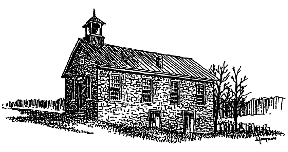Jacob Albright (1758-1808) was born in eastern Pennsylvania to German immigrants. At the age of twenty-seven, he married Catherine Cope, and they bought a farm near Ephrata, Pennsylvania. Albright farmed and ran a successful business producing clay tiles for roofs. His success was due in large part to his reputation for fair dealing; he was called “the honest tile maker.”
Albright had a large family; various accounts name six and nine children. In about 1790, a dysentery epidemic killed at least three of his children and the trauma brought him to a spiritual crisis. Although he was an active member of the Lutheran church, Albright did not have a faith that comforted him in his loss. However, prayer and the guidance of trusted friends eventually brought him an assurance of God’s love and forgiveness.
His renewed faith led him to a Methodist class meeting, and he was soon licensed as an “exhorter,” or lay preacher. By 1796 he was preaching regularly to the German-speaking communities near his home and developing a regular following.
In 1800 Albright organized some adherents into a class in Berks County, Pennsylvania, and two others soon followed. By 1802, the movement had grown to the point that a meeting of all the classes for several days attracted a thousand people. The following year, 1803, the group recognized Jacob Albright as a “genuine Evangelical preacher,” and duly organized themselves as “Albright’s People.” At the first conference in 1807, Albright was elected bishop.
“This Association is…a friendly union of such persons as not merely wish to have the form of godliness, but strive to possess also the power and substance thereof.” (The Doctrines and Disciplines of the Evangelical Association, 1855).
In 1816 the denomination took the name “Evangelical Association.” In 1946, the church merged with the United Brethren in Christ to form the Evangelical United Brethren, and in 1968 that church merged with The Methodist Church to form The United Methodist Church.
In 1850, the Evangelical Association erected a chapel in Albright’s memory in Kleinfeltersville. The land was deeded to the church by the descendents of George Becker, in whose home Albright died in 1808. He was buried in the family plot adjacent to the chapel.
Points of interest at this Heritage Landmark: The chapel was originally dedicated in 1850, but had to be rebuilt ten years later because of faulty construction. For a number of years the chapel housed a local congregation, until the church was erected in nearby Kleinfeltersville. Since then, the chapel has stood as a memorial to Jacob Albright. The interior is furnished to reflect the era of its construction; some items are on display from the life of Jacob Albright.
The cemetery adjacent to the chapel contains Jacob Albright’s grave and those of a number of early Evangelical Association itinerant preachers.
Within sight of the chapel is the house where Albright died, and a short distance away is the home where the first Evangelical conference was held.
There are restrooms on site.
Special events: TBA.
Area attractions: Albright Chapel is in the heart of “Pennsylvania Dutch Country” with its many tourist attractions. Harrisburg is nearby to the west and Philadelphia a short drive to the east. Isaac Long’s Barn, meeting place of Martin Boehm and Philip William Otterbein is north of Lancaster. Other Heritage Landmarks in the annual conference are Boehm’s Chapel, Historic St. George’s United Methodist Church, and Mother African Zoar United Methodist Church.
To visit: The Chapel is not open regular hours. To arrange a tour, contact Ruth Strunk (see address below).
Location: Within the boundaries of the Eastern Pennsylvania Annual Conference, in Lebanon County, Pennsylvania. The chapel is one block north of state route 897 in Kleinfeltersville, which is eleven miles east of Lebanon and twelve miles west of Pennsylvania Turnpike exit 21.
Food and lodging: There are several restaurants and motels along Route 272 just off exit 21 on the Pennsylvania Turnpike.
Directions: Take exit 21 of the Pennsylvania Turnpike; go one mile north on Route 272 to Route 897, then west twelve miles to Kleinfeltersville; follow the signs to Albright Chapel.
For further information, contact: Ruth Strunk, 253 E Main St, Newmanstown, PA 17073; 610-589-2815.
To learn more about United Methodist church history in this area:
Historic St. George’s Church, 235 N. 4th St., Philadelphia, PA 19106; 215-925-7788; Kate Nolan, Archivist; E-mail: kate@historicstgeorges.org.
J. Bruce Behney, The History of the Evangelical United Brethren Church (Nashville: Abingdon Press, 1979).
Robert S. Wilson, Jacob Albright: The Evangelical Pioneer (Myerstown, PA: Church Center Press of Evangelical Congregational Church, 1940).

